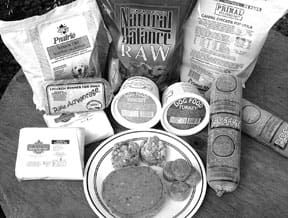by Nancy Kerns
Despite what many makers of conventional canned or dry pet foods would have you believe, raw diets for dogs are not a modern fad, but a return to the dog’s not-so-distant past. While many who advocate “biologically appropriate raw foods” (so-called BARF diets) for dogs point to the canine’s evolutionary diet as justification for this feeding paradigm, the fact is that dogs were thriving on bones and raw meats (and other table scraps) just a hundred years ago – not so long as to imagine that they have since “evolved” out of easily digesting these foods! Kibble and canned, if anything, constitute the modern feeding “fad.”
Most of our grandparents knew how to do a lot of things that most of us don’t know how to do anymore, like canning fresh foods or cleaning a fish. In the name of convenience, we’ve allowed industry to remove us from the process, and we’ve thus lost a lot of common-sense knowledge about the end product. Our grandparents’ generation knew how to feed the family dog – as well as the Best of Show winner at Westminster – on a home-prepared diet.
Fortunately, for today’s over-informed but under-smart dog owners (myself included!), there are companies that offer our dogs a source of food that has the convenience of a prepared diet, the nutritional benefits of a biologically suitable food, and confirmation of space-age laboratory testing that it contains all the nutrients a dog needs (as far as we know so far!).
Why raw? Why meat?
These diets all contain fresh meat – and here, we mean “meat” in its broadest sense; we’re talking about muscle meat, organ meat, bones, fat, connective tissues – all that prey animals have to offer carnivorous predators. Animal proteins offer the most complete array of amino acids required by canines, and the other tissues almost perfectly complete the dog’s nutritional requirements.
Lab tests confirm it: with a little added vegetable matter and some smart if minor supplementation, the best of these meat-based diets meet the nutrient profiles for “complete and balanced” canine diets established by the Association of American Feed Control Officials (AAFCO), just like most dry and canned foods do! Only, because they aren’t cooked, leaving the heat-sensitive nutrients in their fresh ingredients intact, many of these products do not require the addition of a vitamin/mineral supplement to accomplish this feat.
Don’t overlook the importance of raw bone in these formulas; the ones that don’t contain it must contain an adequate substitute source of calcium and other minerals. Many people who feed BARF diets use whole, raw meaty bones such as chicken wings and turkey necks as the major source of calcium in their dogs’ food. Most of these commercial raw diets include ground raw bones, to take advantage of their nutritional value without any of the hazards occasionally posed by bone consumption.
Practice safe steaks
One of the most frequently cited objections that veterinarians have to raw diets is the potential for bacterial contaminants present in the meat to infect and kill your dog, all his canine friends, and indeed, your hapless children and your elderly mother, too.
Well, it’s true: meat infected with E. coli., Salmonella, Campylobacter, and Listeria sickens thousands of people every year. Does this mean that no one should eat meat? Perhaps! Or maybe it means that you should act as if all meat in your home is infected, and handle it accordingly: Employ scrupulous meat-handling and sanitation practices, and leave the consumption of raw meat to your healthy dog, who is naturally and exquisitely well-designed to deal with ingested bacteria.
Handling raw meat in a safe manner is not rocket science. All of the normal precautions of handling the meat eaten by you and your family apply, including:
• People with immune system disorders should avoid handling raw meat. For that matter, raw foods are not suited for immune-compromised dogs, either.
• Keep food frozen until you are ready to feed it. Then, thaw small amounts (only what your dog will eat within a day or two) in the refrigerator. Never, ever allow food to sit for long at room temperature – duh!
If you need to thaw food in a hurry, seal it in a Ziploc bag and place it in warm water for not more than a few minutes.
• Wash your hands with hot water and soap immediately after preparing the dog’s food.
• Promptly wash everything that comes in contact with the food with hot, soapy water: bowls, knives, grinders, countertops and cutting boards. Periodically, use a disinfectant, such as a mild bleach solution. (My chef sister scrubs and soaks her cutting boards with sea salt and lemon juice.)
• Discard any food your dog leaves in his bowl after eating. Don’t allow him to “leave it for later.” Don’t even save it for later in the refrigerator!
• Don’t forget to wash the dog’s water bowl in hot, soapy water daily, as well. Many dogs drink right after eating, and could conceivably contaminate their water with bacteria in their mouths after eating.
Chill out
Ideally, you’ll be able to buy one of these frozen diets from a retailer near you, enabling you to whisk the food home to your freezer. Somewhat less ideal is receiving the product via overnight or two-day delivery, packed in dry ice and/or a cooler.
But anyone who has ever had a birthday present or Amazon.com order arrive late knows that stuff happens. Planes are grounded, storms close highways, etc.
Before you order any product, we suggest that you question the maker closely as to the company policy on shipping mishaps. Who will pay for meat that arrives at room temperature? Because you don’t want your dog to eat it!
Most of the companies ship on a certain day of the week – only on Mondays or Tuesdays, for example – and give you ample notice as to the expected time and date of delivery. Then it’s up to you to be waiting at the door for the delivery truck, so that costly package doesn’t linger on a hot porch.
A few good foods
On the following pages are a number of companies that make and sell raw canine diets (many make cat food, too). The type and quality of their products vary – that is, they vary within the upper- to top-echelon of raw pet food makers!
Some of the products contain grain; most do not. Some of them are “complete and balanced” – a real boon to people who have little experience with home-prepared foods or little support from their veterinarians; other products are meant to provide the foundation of a diet that you design and balance – a job best left to those with superior information resources and professional support.
(Speaking of which: We very much appreciate the companies who provide an overabundance of information about raw feeding in general and their products in particular. For example, every food maker – makers of dry and canned foods included – should be able to provide dog owners with a complete nutritional analysis of their products. And makers of frozen foods must include clear directions for thawing and safe handling.)
None of the companies on this list make food we wouldn’t recommend. But it’s a fact that they, just like dry or canned food makers, use meats of varying quality. Most claim to use USDA inspected and -passed (or “human-quality”) meats. A few claim to use only totally organic ingredients, or sources of meat that were grass-fed, or free of antibiotics and/or growth-hormones. We suggest looking for the best-quality ingredients you can afford.
As always, each dog warrants an individualized diet. Experienced raw feeders will be able to look at the descriptions of the products below and know instantly which foods might be of use to them in building their dogs’ diets. Those who are new to this method of feeding should, ideally, discuss the idea and plan an appropriate diet with their holistic veterinarian or a professional veterinary nutritional consultant who has experience with raw diets. Ask the food makers for their suggestions, too; they have a wealth of experience and a vested interest in helping to demonstrate the benefits, not the pitfalls, of this method of feeding healthy dogs.
Finally, please note that we have not ranked the products in any way; they are presented in alphabetical order.
Also With This Article
Click here to view “The Nutritional Adequacy of Raw Food Diets”
Click here to view “Raw Food Diet Does the Trick”
Click here to view WJD’s Commercial Frozen Raw Food Review





